
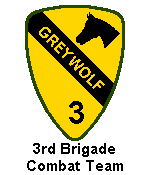
Headquarters
3rd Brigade Combat Team
1st Cavalry Division
Historical Missions
"GreyWolf"


 The Early Years, 1917 - 1942
The Early Years, 1917 - 1942


 The 3rd Brigade, 1st Cavalry Division is a heavily armored, subordinate unit
stationed at Fort Hood, Texas as part of the US Third Mobile Armored Corps.
The history of the 3rd Brigade can be traced back to 29 August 1917, when it
was constituted in the Regular Army as Headquarters, 3rd Cavalry Brigade. On
December 1917, it was organized and assigned to the 15th Cavalry Division at
Camp Harry J. Jones, Arizona. The Brigade's initial wartime service was
patrolling the Mexican Border, until 12 May 1918 when it was relieved from the
15th Cavalry Division and demobilized on 15 July 1919, at Camp Harry J. Jones,
Arizona. On 20 August 1921, the Brigade was reconstituted in the Regular Army
as Headquarters and Headquarters Troop, 3rd Cavalry Brigade, an element of the
2nd Cavalry Division. Never officially reorganized, the Brigade remained on
inactive status until 15 October, 1940 when it was activated at Ft. Riley,
Kansas.
The 3rd Brigade, 1st Cavalry Division is a heavily armored, subordinate unit
stationed at Fort Hood, Texas as part of the US Third Mobile Armored Corps.
The history of the 3rd Brigade can be traced back to 29 August 1917, when it
was constituted in the Regular Army as Headquarters, 3rd Cavalry Brigade. On
December 1917, it was organized and assigned to the 15th Cavalry Division at
Camp Harry J. Jones, Arizona. The Brigade's initial wartime service was
patrolling the Mexican Border, until 12 May 1918 when it was relieved from the
15th Cavalry Division and demobilized on 15 July 1919, at Camp Harry J. Jones,
Arizona. On 20 August 1921, the Brigade was reconstituted in the Regular Army
as Headquarters and Headquarters Troop, 3rd Cavalry Brigade, an element of the
2nd Cavalry Division. Never officially reorganized, the Brigade remained on
inactive status until 15 October, 1940 when it was activated at Ft. Riley,
Kansas.
 World War II - European Theater, 1942 - 1945
World War II - European Theater, 1942 - 1945

 On 15 July 1942, the Brigade was relieved from assignment to the 2nd Cavalry
Division; concurrently converted and redesignated as Headquarters and
Headquarters Company, 9th Armored Division Trains. The 9th Armored Division
landed in Normandy late in September 1944, and first went into line patrol
duty in a quiet sector along the Luxembourg-German frontier on 23 October.
When the Germans launched their winter offensive on 16 December, the 9th, with
no real combat experience, suddenly found itself engaged in heavy fighting.
The Division saw its first action at St. Vith, Echternach, and Bastogne, its
units fighting in widely separated areas.
On 15 July 1942, the Brigade was relieved from assignment to the 2nd Cavalry
Division; concurrently converted and redesignated as Headquarters and
Headquarters Company, 9th Armored Division Trains. The 9th Armored Division
landed in Normandy late in September 1944, and first went into line patrol
duty in a quiet sector along the Luxembourg-German frontier on 23 October.
When the Germans launched their winter offensive on 16 December, the 9th, with
no real combat experience, suddenly found itself engaged in heavy fighting.
The Division saw its first action at St. Vith, Echternach, and Bastogne, its
units fighting in widely separated areas.
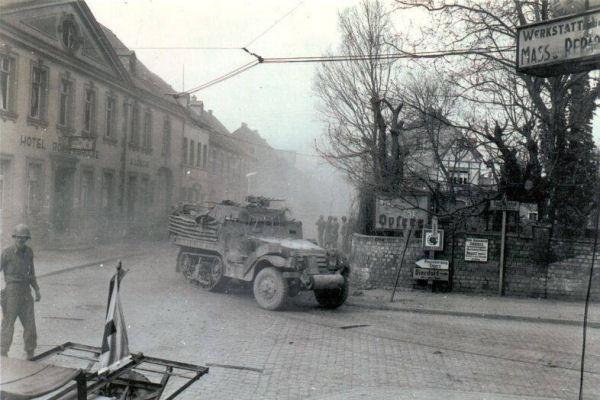 |
|---|
| 9th AD Advances Through Engers, Germany |
|---|
| |
|---|
 Its stand at Bastogne held off the Germans long enough to enable the 101st
Airborne to dig in for a defense of the city. After a rest period in January
1945, the Division made preparations for a drive across the Roer River. The
offensive was launched, 28 February 1945, and the 9th smashed across the Roer
River to Rheinbach, sending patrols into Remagen. The Ludendorff Bridge at
Remagen was found intact, and was seized by elements of the 9th Armored
minutes before demolition charges were set to explode on 07 March 1945. The
Division exploited the bridgehead, moving south and east across the Lahn River
toward Limburg, where thousands of Allied prisoners were liberated.
Its stand at Bastogne held off the Germans long enough to enable the 101st
Airborne to dig in for a defense of the city. After a rest period in January
1945, the Division made preparations for a drive across the Roer River. The
offensive was launched, 28 February 1945, and the 9th smashed across the Roer
River to Rheinbach, sending patrols into Remagen. The Ludendorff Bridge at
Remagen was found intact, and was seized by elements of the 9th Armored
minutes before demolition charges were set to explode on 07 March 1945. The
Division exploited the bridgehead, moving south and east across the Lahn River
toward Limburg, where thousands of Allied prisoners were liberated.
 The Division drove on to Frankfurt and then turned to assist in the closing of
the Ruhr Pocket. In April it continued east, encircling Leipzig and securing a
line along the Mulde River. The Division was shifting south to Czechoslovakia
when the war in Europe ended on 09 May 1945. For their actions, the "HHC", 9th
Armored Division Trains received campaign-participation credit for operations
in the Rhineland, the Ardennes-Alsace, and the Central Europe theatres of war,
and awarded two Meritorious Unit Commendations, with embroidered streamers
reading: Europe 1944 and Europe 1945.
The Division drove on to Frankfurt and then turned to assist in the closing of
the Ruhr Pocket. In April it continued east, encircling Leipzig and securing a
line along the Mulde River. The Division was shifting south to Czechoslovakia
when the war in Europe ended on 09 May 1945. For their actions, the "HHC", 9th
Armored Division Trains received campaign-participation credit for operations
in the Rhineland, the Ardennes-Alsace, and the Central Europe theatres of war,
and awarded two Meritorious Unit Commendations, with embroidered streamers
reading: Europe 1944 and Europe 1945.
 After World War II, the unit returned state-side and was inactivated on 13
October, 1945 at Camp Patrick Henry, VA.
After World War II, the unit returned state-side and was inactivated on 13
October, 1945 at Camp Patrick Henry, VA.
 Demilitarized Zone, 1963 -1965
Demilitarized Zone, 1963 -1965

 The Brigade remained inactive until 15 July 1963 when the 1st Cavalry Division
was transformed by the new Army Division called, Reorganization Objective Army
Division (ROAD) which brought back the triangular Division. At that time the
Brigade was reconstituted in the Regular Army as Headquarters and Headquarters
Company, 3rd Brigade, 1st Cavalry Division and on 01 September 1963, was
activated in Korea on the demilitarized zone. The 3rd Brigade was stationed,
along with the rest of the 1st Cavalry Division, at the facilities of the
former 24th Infantry Division who were stationed at a Headquarters Compound,
redesignated as Camp Howze that was located in the western defense corridor
at Bong il Chong in the Paju City area. The 3rd Brigade and the 1st Cavalry
Division remained headquartered at Camp Howze until it went home on 01 July
1965.
The Brigade remained inactive until 15 July 1963 when the 1st Cavalry Division
was transformed by the new Army Division called, Reorganization Objective Army
Division (ROAD) which brought back the triangular Division. At that time the
Brigade was reconstituted in the Regular Army as Headquarters and Headquarters
Company, 3rd Brigade, 1st Cavalry Division and on 01 September 1963, was
activated in Korea on the demilitarized zone. The 3rd Brigade was stationed,
along with the rest of the 1st Cavalry Division, at the facilities of the
former 24th Infantry Division who were stationed at a Headquarters Compound,
redesignated as Camp Howze that was located in the western defense corridor
at Bong il Chong in the Paju City area. The 3rd Brigade and the 1st Cavalry
Division remained headquartered at Camp Howze until it went home on 01 July
1965.
 Vietnam War, 1965 - 1972
Vietnam War, 1965 - 1972

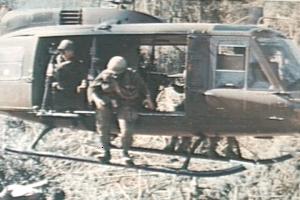 |
|---|
| Air Cavalry Unit |
|---|
| |
|---|
 The 1st Cavalry Division went home in 1965, but only long enough to be
reorganized and be prepared for a new mission. On 03 July 1965, in Doughboy
Stadium at Fort Benning, Georgia the colors of the 11th Air Assault Division
(Test) were cased and retired. As the band played the rousing strains of
GarryOwen, the colors of the 1st Cavalry Division were moved onto the field.
Within 90 days of becoming the Army's first air mobile division, the First
Team was back in combat as the first fully committed division of the Vietnam
War. An advance party, on board C-124s and C-130s, arrived at Nha Trang
between the 19th and 27th of August 1965. They joined with advance liaison
forces and established a temporary base camp near An Khe, 36 miles inland from
the costal city of Qui Nhon.
The 1st Cavalry Division went home in 1965, but only long enough to be
reorganized and be prepared for a new mission. On 03 July 1965, in Doughboy
Stadium at Fort Benning, Georgia the colors of the 11th Air Assault Division
(Test) were cased and retired. As the band played the rousing strains of
GarryOwen, the colors of the 1st Cavalry Division were moved onto the field.
Within 90 days of becoming the Army's first air mobile division, the First
Team was back in combat as the first fully committed division of the Vietnam
War. An advance party, on board C-124s and C-130s, arrived at Nha Trang
between the 19th and 27th of August 1965. They joined with advance liaison
forces and established a temporary base camp near An Khe, 36 miles inland from
the costal city of Qui Nhon.
 On 20 September, the 3rd Brigade of the 1st Cavalry Division debarked from the
troop ship USNS Maurice Rose and marched ashore at the city of Qui Nhon,
Republic of Vietnam. The brigade initially consisted of two airborne infantry
battalions, the 1st and 2nd Battalions, 7th Cavalry. (Note - The third
element of the brigade, the 5th Battalion, was activated and assigned on 01
April 1966.) The brigade loaded quickly into helicopters and moved inland
to the main base camp of the division at An Khe. In the Oriental calendar year
of the "Horse", the airborne soldiers had returned to war wearing the famous
and feared patch of the First Cavalry Division. The "First Team" had entered
its third war - and the longest tour of duty in combat history.
On 20 September, the 3rd Brigade of the 1st Cavalry Division debarked from the
troop ship USNS Maurice Rose and marched ashore at the city of Qui Nhon,
Republic of Vietnam. The brigade initially consisted of two airborne infantry
battalions, the 1st and 2nd Battalions, 7th Cavalry. (Note - The third
element of the brigade, the 5th Battalion, was activated and assigned on 01
April 1966.) The brigade loaded quickly into helicopters and moved inland
to the main base camp of the division at An Khe. In the Oriental calendar year
of the "Horse", the airborne soldiers had returned to war wearing the famous
and feared patch of the First Cavalry Division. The "First Team" had entered
its third war - and the longest tour of duty in combat history.
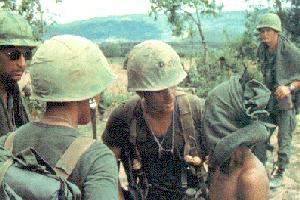 |
|---|
| Interrogating VC Prisoner |
|---|
| |
|---|
 On 23 October 1965, the first real combat test came at the historic order of
General Westmoreland to send the First Team into an air assault mission to
pursue and fight the enemy across 2,500 square miles of jungle. Troopers of
the 1st Brigade and 1st Squadron, 9th Cavalry swooped down on the NVA 33rd
regiment before it could get away from Plei Me. The enemy regiment was
scattered in the confusion and was quickly smashed. The 3rd Brigade joined
the fighting on 09 November. Five days later, the 1st Battalion, 7th Cavalry
air assaulted into the Ia Drang Valley near the Chu Pong Massif. Landing Zone
X-Ray was "hot" from the start. At Landing Zone X-Ray, the Division's first
medal of honor in the Vietnam War was awarded to 2nd Lt. Walter J. Marm of the
1st Battalion 7th Cavalry. The fighting, the most intensive combat in the
history of the division, raged for three days. When the Pleiku Campaign ended
on 25 November, troopers of the First Team had killed 3,561 North Vietnamese
soldiers and captured 157 more. The troopers destroyed two of three regiments
of a North Vietnamese Division, earning the first Presidential Unit Citation
given to a division in Vietnam. The enemy had been given their first major
defeat and their carefully laid plans for conquest had been torn apart.
On 23 October 1965, the first real combat test came at the historic order of
General Westmoreland to send the First Team into an air assault mission to
pursue and fight the enemy across 2,500 square miles of jungle. Troopers of
the 1st Brigade and 1st Squadron, 9th Cavalry swooped down on the NVA 33rd
regiment before it could get away from Plei Me. The enemy regiment was
scattered in the confusion and was quickly smashed. The 3rd Brigade joined
the fighting on 09 November. Five days later, the 1st Battalion, 7th Cavalry
air assaulted into the Ia Drang Valley near the Chu Pong Massif. Landing Zone
X-Ray was "hot" from the start. At Landing Zone X-Ray, the Division's first
medal of honor in the Vietnam War was awarded to 2nd Lt. Walter J. Marm of the
1st Battalion 7th Cavalry. The fighting, the most intensive combat in the
history of the division, raged for three days. When the Pleiku Campaign ended
on 25 November, troopers of the First Team had killed 3,561 North Vietnamese
soldiers and captured 157 more. The troopers destroyed two of three regiments
of a North Vietnamese Division, earning the first Presidential Unit Citation
given to a division in Vietnam. The enemy had been given their first major
defeat and their carefully laid plans for conquest had been torn apart.
 25 January 1966 began "Masher/White Wing" which were code names for the
missions of the 3rd Brigade in Binh Dinh Province. The mission ended 06 March
1966, with the enemy losing its grip on the Binh Dinh Province; however, its
name would be heard again and again during the next six years.
25 January 1966 began "Masher/White Wing" which were code names for the
missions of the 3rd Brigade in Binh Dinh Province. The mission ended 06 March
1966, with the enemy losing its grip on the Binh Dinh Province; however, its
name would be heard again and again during the next six years.
 In August 1966, the 2nd Battalion, 7th Cavalry was sent to Binh Thuan Province
at the southernmost end of II Corps to bring the long months of "Operation
Byrd" to a productive finish. The mission would last till the end of 1966.
In August 1966, the 2nd Battalion, 7th Cavalry was sent to Binh Thuan Province
at the southernmost end of II Corps to bring the long months of "Operation
Byrd" to a productive finish. The mission would last till the end of 1966.
 On October 25, Operation Thayer II continued the drive to pacify the Binh
Dinh Province. On 01 November troopers of the 1st Squadron, 9th Cavalry, 5th
Battalion, 7th Cavalry became engaged in a sharp fight with the 93rd Battalion
and the 2nd Viet Cong Regiment. The action took place in the vicinity of
National Route 1 and Dam Tra-O Lake south of the Gay Giep mountains. In Thayer
II the enemy suffered a punishing loss of 1,757 killed.
On October 25, Operation Thayer II continued the drive to pacify the Binh
Dinh Province. On 01 November troopers of the 1st Squadron, 9th Cavalry, 5th
Battalion, 7th Cavalry became engaged in a sharp fight with the 93rd Battalion
and the 2nd Viet Cong Regiment. The action took place in the vicinity of
National Route 1 and Dam Tra-O Lake south of the Gay Giep mountains. In Thayer
II the enemy suffered a punishing loss of 1,757 killed.
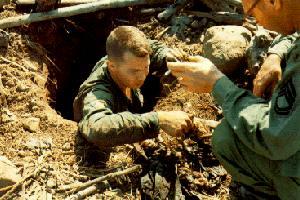 |
|---|
| Exploring VC Cave Networks |
|---|
| |
|---|
 On 13 February 1967, Operation Pershing began in a territory which was
familiar to many skytroopers, the Bong Son Plain in northern Binh Dinh
Province. For the first time, the First Cavalry Division committed all three
of its Brigades to the same battle area. ARVN soldiers familiar with the
methods of the Viet Cong operations in the Bong Son Plain helped the
skytroopers locate and eliminate the numerous caves and tunnels infiltrated by
the enemy. For nearly a year the division scoured the Bong Son Plain, An Lo
valley and the hills of costal II Corps, seeking out enemy units and their
sanctuaries. Pershing became a tedious, unglamorous mission that produced 18
major engagements and numerous minor skirmishes in the 11 month campaign.
On 13 February 1967, Operation Pershing began in a territory which was
familiar to many skytroopers, the Bong Son Plain in northern Binh Dinh
Province. For the first time, the First Cavalry Division committed all three
of its Brigades to the same battle area. ARVN soldiers familiar with the
methods of the Viet Cong operations in the Bong Son Plain helped the
skytroopers locate and eliminate the numerous caves and tunnels infiltrated by
the enemy. For nearly a year the division scoured the Bong Son Plain, An Lo
valley and the hills of costal II Corps, seeking out enemy units and their
sanctuaries. Pershing became a tedious, unglamorous mission that produced 18
major engagements and numerous minor skirmishes in the 11 month campaign.
 The Division began 1968 by terminating Operation Pershing, the longest of the
1st Cavalry's Vietnam actions. When the operation ended on 21 January, the
enemy had lost 5,401 soldiers and 2,400 enemy soldiers had been captured. In
addition, some 1,300 individual and 137 crew weapons had been captured or
destroyed.
The Division began 1968 by terminating Operation Pershing, the longest of the
1st Cavalry's Vietnam actions. When the operation ended on 21 January, the
enemy had lost 5,401 soldiers and 2,400 enemy soldiers had been captured. In
addition, some 1,300 individual and 137 crew weapons had been captured or
destroyed.
 Following fierce fighting at Thorn La Chu, the 3rd Brigade moved toward
embattled city of Hue. The southwest wall of the city was soon taken after the
1st Battalion, 7th Cavalry overcame severe resistance and linked up with the
5th Battalion. At this point, the NVA and Viet Cong invaders were driven from
Hue by late February. The Tet offensive was over. The NVA and Viet Cong had
suffered a massive defeat, with 32,000 killed and 5,800 captured.
Following fierce fighting at Thorn La Chu, the 3rd Brigade moved toward
embattled city of Hue. The southwest wall of the city was soon taken after the
1st Battalion, 7th Cavalry overcame severe resistance and linked up with the
5th Battalion. At this point, the NVA and Viet Cong invaders were driven from
Hue by late February. The Tet offensive was over. The NVA and Viet Cong had
suffered a massive defeat, with 32,000 killed and 5,800 captured.
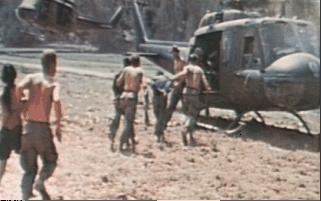 |
|---|
| Air Evacuation |
|---|
| |
|---|
 After shattering the enemy's dreams of a Tet victory, the 1st Cavalry Division
"Sky-Troopers" initiated Operation Pegasus to relieve the 3,500 US Marines and
2,100 ARVN soldiers besieged by nearly 20,000 enemy soldiers. On 01 April
1968, the 3rd Brigade, making a massive air assault within 5 miles of Khe Sanh
were soon followed by the 1st and 2nd Brigades and three ARVN Battalions.
Company "A", 2nd Battalion, 7th Cavalry led the way, followed by Company "C",
2nd Battalion, 7th Cavalry. After four days of tough fighting, they marched
into Khe Sanh to take over the defense of the battered base. Pursing the
retreating North Vietnamese, the 1st Battalion, 12th Cavalry recaptured the
Special Forces camp at Lang Vei uncovering large stockpiles of supplies and
ammunition. The final statistics of Operation Pegasus were 1,259 enemy killed
and more than 750 weapons captured.
After shattering the enemy's dreams of a Tet victory, the 1st Cavalry Division
"Sky-Troopers" initiated Operation Pegasus to relieve the 3,500 US Marines and
2,100 ARVN soldiers besieged by nearly 20,000 enemy soldiers. On 01 April
1968, the 3rd Brigade, making a massive air assault within 5 miles of Khe Sanh
were soon followed by the 1st and 2nd Brigades and three ARVN Battalions.
Company "A", 2nd Battalion, 7th Cavalry led the way, followed by Company "C",
2nd Battalion, 7th Cavalry. After four days of tough fighting, they marched
into Khe Sanh to take over the defense of the battered base. Pursing the
retreating North Vietnamese, the 1st Battalion, 12th Cavalry recaptured the
Special Forces camp at Lang Vei uncovering large stockpiles of supplies and
ammunition. The final statistics of Operation Pegasus were 1,259 enemy killed
and more than 750 weapons captured.
 On April 19 1968, Operation Delaware was launched into the cloud-shrouded A
Shau Valley, near the Laotian border and 45 kilometers west of Hue. None of
the Free World Forces had been in the valley since 1966, which was now being
used as a way station on the supply route known as the Ho Chi Minh Trail. The
first engagement was made by th+e 1st and 3rd Brigades. Under fire from mobile,
37 mm cannon and 0.50 caliber machine guns, they secured several landing
zones. For the next month the brigades scoured the valley floor, clashing with
enemy units and uncovering huge enemy caches of food, arms, ammunition,
rockets, and Russian made tanks and bulldozers. By the time that Operation
Delaware was ended on 17 May, the favorite Viet Cong sanctuary had been
thoroughly disrupted.
On April 19 1968, Operation Delaware was launched into the cloud-shrouded A
Shau Valley, near the Laotian border and 45 kilometers west of Hue. None of
the Free World Forces had been in the valley since 1966, which was now being
used as a way station on the supply route known as the Ho Chi Minh Trail. The
first engagement was made by th+e 1st and 3rd Brigades. Under fire from mobile,
37 mm cannon and 0.50 caliber machine guns, they secured several landing
zones. For the next month the brigades scoured the valley floor, clashing with
enemy units and uncovering huge enemy caches of food, arms, ammunition,
rockets, and Russian made tanks and bulldozers. By the time that Operation
Delaware was ended on 17 May, the favorite Viet Cong sanctuary had been
thoroughly disrupted.
 In February 1969, Operation Cheyenne Sabre with the mission to straddle and
cut enemy infiltration routes began in areas northeast of Bien Hoa. The rest
of the summer was relative calm - until the night of 12 August. The VC threw
simultaneous attacks against Quan Lai, LZBecky, LZJon, LZKelly and LZCaldwell.
The VC were thrown back, experiencing heavy losses as they fled in retreat. In
the final months of 1969, the First Team stymied enemy infiltration along the
roads, trails and narrow paths of the "Serges Jungle Highway" which was hidden
beneath the canopy of heavy jungle growth. The year 1969 ended in a high note
for the 1st Cavalry Division. The enemy's domination of the northern areas of
III Corps had been smashed - thoroughly.
In February 1969, Operation Cheyenne Sabre with the mission to straddle and
cut enemy infiltration routes began in areas northeast of Bien Hoa. The rest
of the summer was relative calm - until the night of 12 August. The VC threw
simultaneous attacks against Quan Lai, LZBecky, LZJon, LZKelly and LZCaldwell.
The VC were thrown back, experiencing heavy losses as they fled in retreat. In
the final months of 1969, the First Team stymied enemy infiltration along the
roads, trails and narrow paths of the "Serges Jungle Highway" which was hidden
beneath the canopy of heavy jungle growth. The year 1969 ended in a high note
for the 1st Cavalry Division. The enemy's domination of the northern areas of
III Corps had been smashed - thoroughly.
 On 01 May 1970, the First Team was "First into Cambodia" hitting what was
previously a Communist sanctuary. President Nixon has given the go-ahead for
the surprise mission. Pushing into the "Fish Hook" region of the border and
occupying the towns of Mimot and Snoul, troopers scattered the enemy forces,
depriving them of much needed supplies and ammunition. On 08 May, the troopers
of the 2nd Brigade found an enemy munitions base that they dubbed "Rock
Island East". Ending on 30 June, the mission to Cambodia far exceeded all
expectations and proved to be one of the most successful operations of the
First Team. All aspects of ground and air combat had been utilized. The enemy
had lost enough men to field three NVA divisions and enough weapons to equip
two divisions. A years supply of rice and corn had been seized. The troopers
and the ARVN soldiers had found uncommonly large quantities of ammunition,
including 1.5 millions rounds for small arms, 200,000 antiaircraft rounds and
143,000 rockets, mortar rounds and recoilless rifle rounds. The sweeps turned
up 300 trucks, a Porsche sports car and a plush Mercedes-Benz sedan.
On 01 May 1970, the First Team was "First into Cambodia" hitting what was
previously a Communist sanctuary. President Nixon has given the go-ahead for
the surprise mission. Pushing into the "Fish Hook" region of the border and
occupying the towns of Mimot and Snoul, troopers scattered the enemy forces,
depriving them of much needed supplies and ammunition. On 08 May, the troopers
of the 2nd Brigade found an enemy munitions base that they dubbed "Rock
Island East". Ending on 30 June, the mission to Cambodia far exceeded all
expectations and proved to be one of the most successful operations of the
First Team. All aspects of ground and air combat had been utilized. The enemy
had lost enough men to field three NVA divisions and enough weapons to equip
two divisions. A years supply of rice and corn had been seized. The troopers
and the ARVN soldiers had found uncommonly large quantities of ammunition,
including 1.5 millions rounds for small arms, 200,000 antiaircraft rounds and
143,000 rockets, mortar rounds and recoilless rifle rounds. The sweeps turned
up 300 trucks, a Porsche sports car and a plush Mercedes-Benz sedan.
 The campaign had severe political repercussions in the United States for the
Nixon Administration. Pressure was mounting to remove America's fighting men
from the Vietnam War. Although there would be further assault operations, the
war was beginning to wind down for many troopers.
The campaign had severe political repercussions in the United States for the
Nixon Administration. Pressure was mounting to remove America's fighting men
from the Vietnam War. Although there would be further assault operations, the
war was beginning to wind down for many troopers.
 Although 26 March 1971 officially marked the end of duties in Vietnam for the
1st Cavalry Division, President Nixon's program of "Vietnamization" required
the continued presence of a strong US fighting force to remain "in country".
On 30 April, a 3rd Brigade (Separate) was organized and activated to carry out
the continuing mission of the 1st Cavalry Division. The mission of the unit,
composed of experienced, specialized fighting units, was to continue the
interdiction of enemy infiltration and supply routes in War Zone D, known as
"Cav" Country.
Although 26 March 1971 officially marked the end of duties in Vietnam for the
1st Cavalry Division, President Nixon's program of "Vietnamization" required
the continued presence of a strong US fighting force to remain "in country".
On 30 April, a 3rd Brigade (Separate) was organized and activated to carry out
the continuing mission of the 1st Cavalry Division. The mission of the unit,
composed of experienced, specialized fighting units, was to continue the
interdiction of enemy infiltration and supply routes in War Zone D, known as
"Cav" Country.
| 3rd Brigade, 1st Cavalry Division (Separate) |
|---|
Regimental Units
2nd Battalion, 5th Cavalry Regiment
1st Battalion, 7th Cavalry Regiment
2nd Battalion, 8th Cavalry Regiment
1st Battalion, 12th Cavalry Regiment |
Brigade Aviation Units
1st Aviation Platoon
"F" Troop, 9th Cavalry (Air)
229th Aviation Battalion
362nd Aviation Company |
Brigade Artillery Units
1st Battalion, 21st Field Artillery
"F" Battery, 26th Artillery (Prov)
"F" Battery, 77th Artillery, Aviation
"F" Battery, 79th Artillery (ARA) "Blue Max"
|
Brigade Support Units
14th Military History Detachment
26th Chemical Detachment
215th Support Battalion
501st Engineer Company
525th Signal Company |
Temporary Duty Unit
2nd Squadron, 11th Armored Cavalry |
Attached Units
34th Inf Platoon, (Scout Dog Patrol)
62nd Inf Platoon, (Combat Trackers)
75th Infantry Rangers, "H" Company
191st Military Intelligence Company
405th Radio Receiver Detachment
483nd Military Police Platoon
Radio Research Detachment (Prov) |
 The 3rd Brigade was well equipped with helicopters from the 229th Assault
Helicopter Battalion and later, a battery of "Blue Max", aerial field units
and two air cavalry troops. A QRF (Quick Reaction Force) - known as "Blue
Platoons", was maintained in support of any air assault action. The "Blues"
traveled light, fought hard and had three primary missions; 1) to form a
"field force" around any helicopter downed by enemy fire or mechanical
failure; 2) to give quick backup to Ranger Patrols who made enemy contact;
and 3) to search for enemy trails, caches and bunker complexes.
The 3rd Brigade was well equipped with helicopters from the 229th Assault
Helicopter Battalion and later, a battery of "Blue Max", aerial field units
and two air cavalry troops. A QRF (Quick Reaction Force) - known as "Blue
Platoons", was maintained in support of any air assault action. The "Blues"
traveled light, fought hard and had three primary missions; 1) to form a
"field force" around any helicopter downed by enemy fire or mechanical
failure; 2) to give quick backup to Ranger Patrols who made enemy contact;
and 3) to search for enemy trails, caches and bunker complexes.
 On 30 March 1972, General Giap of the North Vietnamese Army began an offensive
across the DMZ in a final attempt to unify the North and South. By 03 April,
these thrusts became a full scale attack. More than 48,000 NVA and VC troops
hit Loc Ninh. Two days later, on 05 April, the North Vietnamese threw heavy
assaults against An Loc and announced that by 20 April, An Loc would be the
new capital of the South for the North Vietnamese.
On 30 March 1972, General Giap of the North Vietnamese Army began an offensive
across the DMZ in a final attempt to unify the North and South. By 03 April,
these thrusts became a full scale attack. More than 48,000 NVA and VC troops
hit Loc Ninh. Two days later, on 05 April, the North Vietnamese threw heavy
assaults against An Loc and announced that by 20 April, An Loc would be the
new capital of the South for the North Vietnamese.
 In April and May, stepped up bombings by B-52's helped blunt the North
Vietnamese invasion. Large groups of enemy soldiers were caught in the open
fields and entire NVA units were destroyed. Helicopters and gunships from the
3rd Brigade saw heavy action at An Loc and Loc Ninh, engaging heavy armor as
well as ground troops. The intensity of the fighting took a heavy toll on
them. For example, on 12 May, five Cobra Ships were destroyed in less than 30
minutes by Chinese Surface-to-Air (SA-7) Missiles.
In April and May, stepped up bombings by B-52's helped blunt the North
Vietnamese invasion. Large groups of enemy soldiers were caught in the open
fields and entire NVA units were destroyed. Helicopters and gunships from the
3rd Brigade saw heavy action at An Loc and Loc Ninh, engaging heavy armor as
well as ground troops. The intensity of the fighting took a heavy toll on
them. For example, on 12 May, five Cobra Ships were destroyed in less than 30
minutes by Chinese Surface-to-Air (SA-7) Missiles.
 On 15 May, relief units, moving down Highway 13, broke through and helped lift
the bitter siege of An Loc. The North Vietnamese were reeling from huge losses
and began to withdraw to their sanctuaries in Cambodia and Laos. Their spring
offensive aimed at cutting South Vietnam in half and capturing Saigon had been
decisively smashed. The helo air effort of the 3rd Brigade had turned in a
magnificent performance in support of the remaining advisors with the ARVN
units. During the period of 05 April through 15 May 1972, more than 100 T54
tanks, armored personnel carriers and anti-aircraft guns were knocked out in
the area around An Loc.
On 15 May, relief units, moving down Highway 13, broke through and helped lift
the bitter siege of An Loc. The North Vietnamese were reeling from huge losses
and began to withdraw to their sanctuaries in Cambodia and Laos. Their spring
offensive aimed at cutting South Vietnam in half and capturing Saigon had been
decisively smashed. The helo air effort of the 3rd Brigade had turned in a
magnificent performance in support of the remaining advisors with the ARVN
units. During the period of 05 April through 15 May 1972, more than 100 T54
tanks, armored personnel carriers and anti-aircraft guns were knocked out in
the area around An Loc.
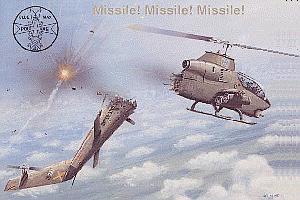 |
|---|
| Missile! Missile! Missile! |
|---|
| |
|---|
 Joseph Kline, Co "B", 104th Avn Bn, 101st Airborne Division captured the
intensity and energy typical of subsequent air battles with his painting
"Missile! Missile! Missile" which portrays the situation of Captains Mike
Brown and Marco Cordon, "F" Btry, 79th ARA, whose Cobra took a direct hit of a
Surface-to-Air (SA-7) Missile at 4,000 feet while on a mission in support of
an ARVN airborne brigade in the vicinity of Tan Khai on highway 13,
approximately 6 miles south of An Loc. Only sound training and the instinct
for survival lead to their safe return.
Joseph Kline, Co "B", 104th Avn Bn, 101st Airborne Division captured the
intensity and energy typical of subsequent air battles with his painting
"Missile! Missile! Missile" which portrays the situation of Captains Mike
Brown and Marco Cordon, "F" Btry, 79th ARA, whose Cobra took a direct hit of a
Surface-to-Air (SA-7) Missile at 4,000 feet while on a mission in support of
an ARVN airborne brigade in the vicinity of Tan Khai on highway 13,
approximately 6 miles south of An Loc. Only sound training and the instinct
for survival lead to their safe return.
 By 31 March 1972, only 96,000 U.S. troops were involved in the Vietnam combat
operations. In mid June 1972, the standdown ceremony for the 3rd Brigade was
held in Bein Hoa and the colors were returned to the United States. The last
trooper left from Tan Son Nhut on 21 June, completing the division recall
which had started on 05 May 1971. With the 3rd Brigade completing their
withdraw, the 1st Cavalry had been the first army division to go to Vietnam
and the last to leave.
By 31 March 1972, only 96,000 U.S. troops were involved in the Vietnam combat
operations. In mid June 1972, the standdown ceremony for the 3rd Brigade was
held in Bein Hoa and the colors were returned to the United States. The last
trooper left from Tan Son Nhut on 21 June, completing the division recall
which had started on 05 May 1971. With the 3rd Brigade completing their
withdraw, the 1st Cavalry had been the first army division to go to Vietnam
and the last to leave.
"Firsts" had become the trademark of the First Team.
 Return To Conus , 1972
Return To Conus , 1972

 On 26 June 1972, the 1st Battalion, 7th Cavalry; 2nd Battalion, 8th Cavalry;
and the 1st Battalion, 12th Cavalry along with the 3rd Brigade (Separate) was
brought back to the United States, completing the last stage of the "Vietnam
recall" for the 1st Cavalry Division. The return of the units brought about
several changes to the organizational structure of the 1st Cavalry Division
over the next several years.
On 26 June 1972, the 1st Battalion, 7th Cavalry; 2nd Battalion, 8th Cavalry;
and the 1st Battalion, 12th Cavalry along with the 3rd Brigade (Separate) was
brought back to the United States, completing the last stage of the "Vietnam
recall" for the 1st Cavalry Division. The return of the units brought about
several changes to the organizational structure of the 1st Cavalry Division
over the next several years.
 On 27 January 1973, a cease-fire was signed in Paris by the United States,
South Vietnam, North Vietnam, and the Provisional Revolutionary Government
of the National Liberation Front (NLF), the civilian arm of the South Vietnam
Communists. A Four-Party Joint Military Commission was set up to implement
such provisions as the withdrawal of foreign troops and the release of
prisoners. An International Commission of Control and Supervision was
established to oversee the cease-fire.
On 27 January 1973, a cease-fire was signed in Paris by the United States,
South Vietnam, North Vietnam, and the Provisional Revolutionary Government
of the National Liberation Front (NLF), the civilian arm of the South Vietnam
Communists. A Four-Party Joint Military Commission was set up to implement
such provisions as the withdrawal of foreign troops and the release of
prisoners. An International Commission of Control and Supervision was
established to oversee the cease-fire.
 During the 1970s, 1980s, and the beginning of the 1990s a crucial part of US
Army doctrine of "Total Force" employed the use of "Roundout Brigades". The
use of this concept included the flexibility or changes in either staffing or
equipment resources by the attachment/assignment of either an Army Reserve or
National Guard unit to the Regular Army Divisions. Implementation of these
plans included the close supervision and/or training of these "roundout
brigades" by the active parent division. In the implementation of the
"roundout concept", several active duty divisions reorganized their staffing
around the use of two active duty brigades and one brigade of either the
National Guard or Army Reserve. The 1st Cavalry Division, one of the active
divisions planning to take advantage of the "roundout resources", inactivated
the 3rd Brigade at Ft. Hood, Texas on 15 September 1980.
During the 1970s, 1980s, and the beginning of the 1990s a crucial part of US
Army doctrine of "Total Force" employed the use of "Roundout Brigades". The
use of this concept included the flexibility or changes in either staffing or
equipment resources by the attachment/assignment of either an Army Reserve or
National Guard unit to the Regular Army Divisions. Implementation of these
plans included the close supervision and/or training of these "roundout
brigades" by the active parent division. In the implementation of the
"roundout concept", several active duty divisions reorganized their staffing
around the use of two active duty brigades and one brigade of either the
National Guard or Army Reserve. The 1st Cavalry Division, one of the active
divisions planning to take advantage of the "roundout resources", inactivated
the 3rd Brigade at Ft. Hood, Texas on 15 September 1980.
 In early 1983, in order to offset the need of increased staffing requirements
caused by the inactivation of the 3rd Brigade, the 1st Cavalry Division, as
planned, took advantage of the Army Total Forces - Roundout Brigade Program.
The Roundout Program, designed and controlled by DOD, in conjunction with
State Legislators, had promised to bring any of the participating divisions up
to full strength when mobilized. In anticipation of fulfilling its manpower
staffing and equipment needs during their continuous reorganization for combat
against unknown enemies of the future, the 1st Cavalry Division attached the
155th Armored Brigade, Mississippi Army National Guard to functionally operate
as its third brigade.
In early 1983, in order to offset the need of increased staffing requirements
caused by the inactivation of the 3rd Brigade, the 1st Cavalry Division, as
planned, took advantage of the Army Total Forces - Roundout Brigade Program.
The Roundout Program, designed and controlled by DOD, in conjunction with
State Legislators, had promised to bring any of the participating divisions up
to full strength when mobilized. In anticipation of fulfilling its manpower
staffing and equipment needs during their continuous reorganization for combat
against unknown enemies of the future, the 1st Cavalry Division attached the
155th Armored Brigade, Mississippi Army National Guard to functionally operate
as its third brigade.
 AUTHOR's NOTE: When the nation critically needed the Roundout Brigade
Program concept to work during Operation DESERT STORM, neither the 1st Cavalry
Division nor the 24th Infantry Division (Mechanized) deployed with their
roundout brigades. In early 1991, the US Army began a move at reducing the
combat role of reservists and changed its basic tenant of the "Total Force"
policy. In parallel, it began a massive restructuring effort to deal with a
smaller military force by 1995.
AUTHOR's NOTE: When the nation critically needed the Roundout Brigade
Program concept to work during Operation DESERT STORM, neither the 1st Cavalry
Division nor the 24th Infantry Division (Mechanized) deployed with their
roundout brigades. In early 1991, the US Army began a move at reducing the
combat role of reservists and changed its basic tenant of the "Total Force"
policy. In parallel, it began a massive restructuring effort to deal with a
smaller military force by 1995.
 As modifications were made to the reserve training program, the reserve units
made significant contributions to the continuing Middle East conflicts. The
155th Armored Brigade, Mississippi Army National Guard successfully carried
out and met the objectives of the following recent deployments:
As modifications were made to the reserve training program, the reserve units
made significant contributions to the continuing Middle East conflicts. The
155th Armored Brigade, Mississippi Army National Guard successfully carried
out and met the objectives of the following recent deployments:
- Stabilization Force (SFOR) 10 (Oct. 2001 - Apr 2002): The NATO-led
multinational force in Bosnia and Herzegovina.
- Operation Iraqi Freedom III (Aug 2004 to Jan 2006): The brigade
served under the II Marine Expeditionary Force.
- Operation Iraqi Freedom VI (2009); Headquartered at Camp Taji,
Iraq with subordinate units spread throughout Iraq.
 Persian Gulf War - Southwest Asia, 1990 - 1991
Persian Gulf War - Southwest Asia, 1990 - 1991

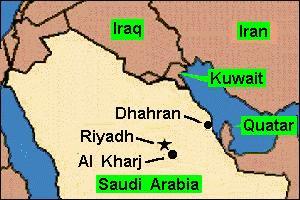 |
|---|
| Theater of Operations |
|---|
| |
|---|
 In August 1990, the 1st Cavalry Division was alerted for deployment to
Southwest Asia as part of the joint forces participating in Operation Desert
Shield. The focus at that time was the defense of Saudi Arabia against
potential Iraqi attack. Although the 3rd Brigade had not been reactivated for
the deployment, members of the "Tiger" Brigade, the 1st Battalion, 67th Armor
Regiment, 2nd Armored Division, reflagged as the 3rd Battalion, 8th Cavalry
Regiment and the 3rd Battalion, 41st Infantry, 2nd Armored Division, reflagged
as the 1st Battalion, 9th Cavalry Regiment in 1992, when the 3rd Brigade was
reactivated, did play a significant role in the battle.
In August 1990, the 1st Cavalry Division was alerted for deployment to
Southwest Asia as part of the joint forces participating in Operation Desert
Shield. The focus at that time was the defense of Saudi Arabia against
potential Iraqi attack. Although the 3rd Brigade had not been reactivated for
the deployment, members of the "Tiger" Brigade, the 1st Battalion, 67th Armor
Regiment, 2nd Armored Division, reflagged as the 3rd Battalion, 8th Cavalry
Regiment and the 3rd Battalion, 41st Infantry, 2nd Armored Division, reflagged
as the 1st Battalion, 9th Cavalry Regiment in 1992, when the 3rd Brigade was
reactivated, did play a significant role in the battle.
 "The Tiger Battle Team", assigned to the 1st Cavalry Division, joined the 2nd
Marine Division as the main forces of the 1st Cavalry Division rushed to the
defense of the Wadi al Batin. With its Abrams, Bradleys and self propelled
artillery, the "Tiger" Brigade was now poised to attack north in support of
the lightly armored Marines. At 2:00 PM of 24 February, the command post
rolled through the 30 foot of the bern and ninety minutes later TF 3-41
Infantry crossed in column, buttoned up in chemical gear. Mine plow-equipped
tanks led the way, widening the lanes. Within fifteen minutes, TF 3-41
Infantry cleared the first two minefields safely.
"The Tiger Battle Team", assigned to the 1st Cavalry Division, joined the 2nd
Marine Division as the main forces of the 1st Cavalry Division rushed to the
defense of the Wadi al Batin. With its Abrams, Bradleys and self propelled
artillery, the "Tiger" Brigade was now poised to attack north in support of
the lightly armored Marines. At 2:00 PM of 24 February, the command post
rolled through the 30 foot of the bern and ninety minutes later TF 3-41
Infantry crossed in column, buttoned up in chemical gear. Mine plow-equipped
tanks led the way, widening the lanes. Within fifteen minutes, TF 3-41
Infantry cleared the first two minefields safely.
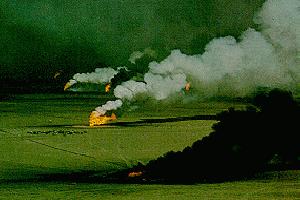 |
|---|
| Apocalyptic World of Hellfire |
|---|
| |
|---|
 The others began to move. TF 3-67 Armor on the left and TF 1-67 on the right
to bring them, out from six lanes to a bridge wedge, with 1-3 Field Artillery
trailing in the center. The Brigade moved on into the dreamscape of Southern
Kuwait, an apocalyptic world of hellfire with more than 500 oil wells set
ablaze by the Iraqis before they surrendered, The smoke drifted north,
darkening the sky over the 1st Cavalry near Basrah and the Euphrates River
Vallley. The debris of the war littered the flat desert; spent bomb casings,
unexploded rockets standing like quills in the stand, wrecked and blackened
equipment.
The others began to move. TF 3-67 Armor on the left and TF 1-67 on the right
to bring them, out from six lanes to a bridge wedge, with 1-3 Field Artillery
trailing in the center. The Brigade moved on into the dreamscape of Southern
Kuwait, an apocalyptic world of hellfire with more than 500 oil wells set
ablaze by the Iraqis before they surrendered, The smoke drifted north,
darkening the sky over the 1st Cavalry near Basrah and the Euphrates River
Vallley. The debris of the war littered the flat desert; spent bomb casings,
unexploded rockets standing like quills in the stand, wrecked and blackened
equipment.
 At dawn of the 25th, TF 3-41 Infantry hit a bunker complex spotted the night
before. In an approach repeated over the next two days, tanks and Bradleys
the bunkers from up to 2,500 yards away, then sent in dismounted Infantry.
The defenders, in disarray, gave up readily. They quickly realized, as one
said "We have nothing that can touch you".
At dawn of the 25th, TF 3-41 Infantry hit a bunker complex spotted the night
before. In an approach repeated over the next two days, tanks and Bradleys
the bunkers from up to 2,500 yards away, then sent in dismounted Infantry.
The defenders, in disarray, gave up readily. They quickly realized, as one
said "We have nothing that can touch you".
 Force Restructuring, 1991 - 1993
Force Restructuring, 1991 - 1993

 On 21 May 1991, the 1st Cavalry Division became the largest division in the
Army, with the reactivation of its 3rd (Greywolf) Brigade. Organic units
included in this reactivation were formally assigned to the 1st (Tiger)
Brigade, 2nd Armored Division that, at times, had been attached to the 1st
Cavalry Division during the Gulf War. Units filling out the 3rd Brigade were
3rd Battalion, 41st Infantry Regiment, 1st and 3rd Battalions, 67th Armor
Regiment, 1st Battalion, 3rd Field Artillery Regiment and the 502nd
(later redesignated as the 215th) Forward Support Battalion.
On 21 May 1991, the 1st Cavalry Division became the largest division in the
Army, with the reactivation of its 3rd (Greywolf) Brigade. Organic units
included in this reactivation were formally assigned to the 1st (Tiger)
Brigade, 2nd Armored Division that, at times, had been attached to the 1st
Cavalry Division during the Gulf War. Units filling out the 3rd Brigade were
3rd Battalion, 41st Infantry Regiment, 1st and 3rd Battalions, 67th Armor
Regiment, 1st Battalion, 3rd Field Artillery Regiment and the 502nd
(later redesignated as the 215th) Forward Support Battalion.
 Since the Gulf War, the 3rd Brigade has participated in several NTC rotations,
deployed a tack force sized element to the Emirate of Kuwait and in September
1996, conducted the first post Desert Storm, no notice, brigade-sized
deployment in Kuwait in support of "Operation Desert Strike".
Since the Gulf War, the 3rd Brigade has participated in several NTC rotations,
deployed a tack force sized element to the Emirate of Kuwait and in September
1996, conducted the first post Desert Storm, no notice, brigade-sized
deployment in Kuwait in support of "Operation Desert Strike".
 Desert Peacekeepers, 1996 - 2000
Desert Peacekeepers, 1996 - 2000

 On 26 August 1996, in response to "Operation Intrinsic Action 96-3", Task
Force 1-9 comprised of soldiers from the 3rd "Greywolf" Brigade had come to
Camp Doha for extensive ground training. Iraq was quiet, but the soldiers of
the First Team were back at Camp Doha, Kuwait. Task Force 1-9, part of the 3rd
"Greywolf" Brigade, was comprised of elements from:
On 26 August 1996, in response to "Operation Intrinsic Action 96-3", Task
Force 1-9 comprised of soldiers from the 3rd "Greywolf" Brigade had come to
Camp Doha for extensive ground training. Iraq was quiet, but the soldiers of
the First Team were back at Camp Doha, Kuwait. Task Force 1-9, part of the 3rd
"Greywolf" Brigade, was comprised of elements from:
3rd "Greywolf" Brigade, 1st Cavalry Division;
Headquarters Company, 1st Battalion, 9th Cavalry Regiment;
"D" Company, 1st Battalion, 9th Cavalry Regiment;
"B" Company, 1st Battalion, 12th Cavalry Regiment;
"D" Company, 1st Battalion, 12th Cavalry Regiment;
"A" Battery, 2nd Battalion, 82nd Field Artillery;
"A" Company, 8th Engineer Battalion;
215th Forward Support Battalion;
15th Finance Battalion.
 Immediately after the jet-engines of the transport airplanes were silenced,
Task Force 1-9 hit the ground running. Following a bus ride to Camp Doha, the
3rd "Greywolf" Brigade put a carefully planned operation into action.
Immediately after the jet-engines of the transport airplanes were silenced,
Task Force 1-9 hit the ground running. Following a bus ride to Camp Doha, the
3rd "Greywolf" Brigade put a carefully planned operation into action.
 A row of Bradley Fighting Vehicles lay in wait for their crews at the Tactical
Assembly Area Tuesday. Once there, the troops picked up force protection
ammunition and moved to the marshaling area for staging and reorganization.
Tracked vehicles were loaded onto heavy equipment transports and lowboys for
transport to the Logistical Release Point One at Tactical Assembly Area
Headhunter.
A row of Bradley Fighting Vehicles lay in wait for their crews at the Tactical
Assembly Area Tuesday. Once there, the troops picked up force protection
ammunition and moved to the marshaling area for staging and reorganization.
Tracked vehicles were loaded onto heavy equipment transports and lowboys for
transport to the Logistical Release Point One at Tactical Assembly Area
Headhunter.
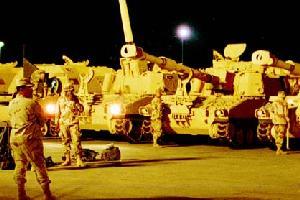 |
|---|
| M109A6 Paladin Howitzers |
|---|
| |
|---|
 The 1st Cavalry Division earned its nickname, America's First Team, by being
the first unit to do so many things. First in Tokyo, First in Korea, First in
Vietnam, First heavy armored division into Iraq and now the first to use the
M109A6 Paladin Howitzer in Kuwait.
The 1st Cavalry Division earned its nickname, America's First Team, by being
the first unit to do so many things. First in Tokyo, First in Korea, First in
Vietnam, First heavy armored division into Iraq and now the first to use the
M109A6 Paladin Howitzer in Kuwait.
 Artillerymen from "A" Battery, 2nd Battalion, 82nd Field Artillery soldiers
were the first to use the new M109A6 Paladin Howitzers on Udaira Range in
Kuwait. The use of this new weapon provided an excellent opportunity for the
1-9 Force Team to demonstrate their ability to project combat power anywhere
in the world, showing their allies and others the resolve of the United States
to maintain peace.
Artillerymen from "A" Battery, 2nd Battalion, 82nd Field Artillery soldiers
were the first to use the new M109A6 Paladin Howitzers on Udaira Range in
Kuwait. The use of this new weapon provided an excellent opportunity for the
1-9 Force Team to demonstrate their ability to project combat power anywhere
in the world, showing their allies and others the resolve of the United States
to maintain peace.
 As the Task Force 1-9 were engaged in their training exercises, word came of
the Alert sounded for their comrades at Fort Hood, Texas. Tensions in the Gulf
areas increased when the Iraqi troops moved into a "safe haven" of Irbil in
northern Iraq.
As the Task Force 1-9 were engaged in their training exercises, word came of
the Alert sounded for their comrades at Fort Hood, Texas. Tensions in the Gulf
areas increased when the Iraqi troops moved into a "safe haven" of Irbil in
northern Iraq.
 On 17 September after several days of preparation, the III Armored Corps was
given the green light to deploy additional forces to Kuwait as part of
Exercise Intrinsic Action. The deploying units, a US Army Brigade Combat Team
of approximately 3,500 soldiers, consisted of the 1st Battalion, 5th Cavalry
Regiment, 3rd Battalion, 8th Cavalry Regiment, the remainder of the 82nd Field
Artillery, support personnel from Battery "A" 21st Multiple Rocket System,
68th Chemical Company and the 13th Signal Battalion deployed from Robert Gray
Army Airfield to augment their elements already with Task Force 1-9.
On 17 September after several days of preparation, the III Armored Corps was
given the green light to deploy additional forces to Kuwait as part of
Exercise Intrinsic Action. The deploying units, a US Army Brigade Combat Team
of approximately 3,500 soldiers, consisted of the 1st Battalion, 5th Cavalry
Regiment, 3rd Battalion, 8th Cavalry Regiment, the remainder of the 82nd Field
Artillery, support personnel from Battery "A" 21st Multiple Rocket System,
68th Chemical Company and the 13th Signal Battalion deployed from Robert Gray
Army Airfield to augment their elements already with Task Force 1-9.
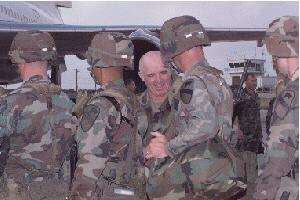 |
|---|
| Maj. Gen. La Porte Visits Departing Troops |
|---|
| |
|---|
 The deploying 1st Cavalry Division forces reinforced the 1,200 soldiers who
have been in Kuwait training with the Kuwaiti armed forces as part of exercise
Intrinsic Action 96-3 since early August. Troops deployed with individual arms
and equipment by air from Robert Gray Army Airfield at Ft. Hood, Texas and
utilized equipment such as M1A1 Abrams tanks and M2A2 Bradley Fighting
Vehicles previously prepositioned in the Kuwait theater.
The deploying 1st Cavalry Division forces reinforced the 1,200 soldiers who
have been in Kuwait training with the Kuwaiti armed forces as part of exercise
Intrinsic Action 96-3 since early August. Troops deployed with individual arms
and equipment by air from Robert Gray Army Airfield at Ft. Hood, Texas and
utilized equipment such as M1A1 Abrams tanks and M2A2 Bradley Fighting
Vehicles previously prepositioned in the Kuwait theater.
 The soldiers of Task Force 1-9 and the reinforcements, dug in and were not
going anywhere until it was sure that there was no threat to Kuwait. The
leaders made good use of the opportunities provided by Kuwait's Udairi Range
to hone fighting skills to a razor-sharp edge.
The soldiers of Task Force 1-9 and the reinforcements, dug in and were not
going anywhere until it was sure that there was no threat to Kuwait. The
leaders made good use of the opportunities provided by Kuwait's Udairi Range
to hone fighting skills to a razor-sharp edge.
 The soldiers weren't finished, however. After training themselves, it was time
for the soldiers to meet with their hosts, the Kuwaiti Army, and forces from
the United Kingdom. The three countries learned to integrate their forces.
Language barriers fell with the help of linguists, and soldiers began to learn
the strengths of their coalition partners. The hard work all paid off, on 20
November, the three countries came together for a Combined Arms Live Fire
Exercise that ended the live-fire portion of Intrinsic Action 96-3.
The soldiers weren't finished, however. After training themselves, it was time
for the soldiers to meet with their hosts, the Kuwaiti Army, and forces from
the United Kingdom. The three countries learned to integrate their forces.
Language barriers fell with the help of linguists, and soldiers began to learn
the strengths of their coalition partners. The hard work all paid off, on 20
November, the three countries came together for a Combined Arms Live Fire
Exercise that ended the live-fire portion of Intrinsic Action 96-3.
 The "GreyWolf" Brigade Combat Team had performed flawlessly on every mission.
Without serious accident or incident, it conducted live fire and maneuver
training at a wartime pace. Averaging more than 500 miles per vehicle and
firing all its weapon systems, the 3rd Brigade Combat Team was fully trained
in its Mission Essential Task List. The Grey Wolf soldiers accomplished this
while maintaining their vehicles above a 90% operational readiness rate.
The "GreyWolf" Brigade Combat Team had performed flawlessly on every mission.
Without serious accident or incident, it conducted live fire and maneuver
training at a wartime pace. Averaging more than 500 miles per vehicle and
firing all its weapon systems, the 3rd Brigade Combat Team was fully trained
in its Mission Essential Task List. The Grey Wolf soldiers accomplished this
while maintaining their vehicles above a 90% operational readiness rate.
 As Task Force 1-9 stood up and demonstrated their fighting ability, it became
evident that Iraq wasn't looking for a fight. It pulled its forces from
northern Iraq and agreed to honor a newly-extended no-fly zone. In December,
the Task Force, with their mission assignment completed, returned to Fort
Hood.
As Task Force 1-9 stood up and demonstrated their fighting ability, it became
evident that Iraq wasn't looking for a fight. It pulled its forces from
northern Iraq and agreed to honor a newly-extended no-fly zone. In December,
the Task Force, with their mission assignment completed, returned to Fort
Hood.
 Operation ENDURING FREEDOM, 2001
Operation ENDURING FREEDOM, 2001

 In November 2001, as a direct response to the attacks of September 11th, Task
Force Black Jack deployed to Kuwait as a participant in "Operation Enduring
Freedom". The Brigade Combat Team prepared and subsequently deployed in
November 2001, fourteen days after notification, and returned to Fort Hood in
early April 2002 following a highly successful operational deployment.
In November 2001, as a direct response to the attacks of September 11th, Task
Force Black Jack deployed to Kuwait as a participant in "Operation Enduring
Freedom". The Brigade Combat Team prepared and subsequently deployed in
November 2001, fourteen days after notification, and returned to Fort Hood in
early April 2002 following a highly successful operational deployment.
 Operation IRAQI FREEDOM II, 2003 - 2005
Operation IRAQI FREEDOM II, 2003 - 2005

 The BlackJack brigade deployed to Iraq in January 2004 as the lead element for
the Division in support of Operation Iraqi Freedom I. During the initial
deployment, the 2nd BCT was attached to the 1st Armored Division and patrolled
Western Baghdad. The brigade fell back under the 1st Cavalry Division in May
2004. During OIF I/II deployment, a 14 month combat tour, the Soldiers saw
action in Western Baghdad, An Najef, Fallujah, and Northern Babil.
The BlackJack brigade deployed to Iraq in January 2004 as the lead element for
the Division in support of Operation Iraqi Freedom I. During the initial
deployment, the 2nd BCT was attached to the 1st Armored Division and patrolled
Western Baghdad. The brigade fell back under the 1st Cavalry Division in May
2004. During OIF I/II deployment, a 14 month combat tour, the Soldiers saw
action in Western Baghdad, An Najef, Fallujah, and Northern Babil.
 Army Modular Forces, 2005
Army Modular Forces, 2005

 On 24 May, following six months of extensive planning, officers of the 1st
Cavalry Division began executing the monumental task of reorganizing and
realigning its manpower and equipment resources into the Army Matrix of Modular
Forces. As each Brigade changed command, they changed their colors and become
a Brigade Unit of Action (BUA). Having completed their deployment cycle, the
Black Jack Brigade, as part of the reorganizational process, underwent modular
transformation into a Brigade Combat Team.
On 24 May, following six months of extensive planning, officers of the 1st
Cavalry Division began executing the monumental task of reorganizing and
realigning its manpower and equipment resources into the Army Matrix of Modular
Forces. As each Brigade changed command, they changed their colors and become
a Brigade Unit of Action (BUA). Having completed their deployment cycle, the
Black Jack Brigade, as part of the reorganizational process, underwent modular
transformation into a Brigade Combat Team.
 During their reconstitution, the Black Jack brigade once again answered the
call of our Nation and deployed to New Orleans, LA, in support of the
humanitarian Relief effort following Hurricane Katrina. During the deployment,
Black Jack provided humanitarian and military assistance to the local
governance and to the citizens of the Algiers district.
During their reconstitution, the Black Jack brigade once again answered the
call of our Nation and deployed to New Orleans, LA, in support of the
humanitarian Relief effort following Hurricane Katrina. During the deployment,
Black Jack provided humanitarian and military assistance to the local
governance and to the citizens of the Algiers district.
 Operation IRAQI FREEDOM IV, 2006 - 2008
Operation IRAQI FREEDOM IV, 2006 - 2008

 The "GREYWOLF" Brigade deployed again to Iraq in 2006 in support of Operation
Iraqi Freedom IV. The Brigade was responsible for the Diyala Province and the
capital city of Baqubah and conducted operations in the Salah ah Din Province.
The "GREYWOLF" Brigade was responsible for defeating al Qaeda in Baqubah
along with the restoration of stability and civil services throughout the
Diyala Province.
The "GREYWOLF" Brigade deployed again to Iraq in 2006 in support of Operation
Iraqi Freedom IV. The Brigade was responsible for the Diyala Province and the
capital city of Baqubah and conducted operations in the Salah ah Din Province.
The "GREYWOLF" Brigade was responsible for defeating al Qaeda in Baqubah
along with the restoration of stability and civil services throughout the
Diyala Province.
 Operation IRAQI FREEDOM VI, 2008 - 2010
Operation IRAQI FREEDOM VI, 2008 - 2010

 In December 2007, the "GREYWOLF" Brigade deployed to Iraq for a third time.
Responsible for the Ninewa Province in northern Iraq, the Brigade conducted
full-spectrum operations to neutralize Al Qaeda in Iraq (AQI) and
Irreconcilable Elements to improve security, stimulate economic growth and
create enduring stability. In accordance with the Security Agreement, the
"GREYWOLF" Brigade moved operations outside of cities and transitioned
security primacy within Mosul and Tal Afar to the Iraqi Security Forces. The
Brigade continued to conduct full-spectrum operations outside of Mosul to
prevent insurgents from using the Mosul Belts as support zones to conduct
attacks within the city, setting the conditions for National Elections of
Iraq.
In December 2007, the "GREYWOLF" Brigade deployed to Iraq for a third time.
Responsible for the Ninewa Province in northern Iraq, the Brigade conducted
full-spectrum operations to neutralize Al Qaeda in Iraq (AQI) and
Irreconcilable Elements to improve security, stimulate economic growth and
create enduring stability. In accordance with the Security Agreement, the
"GREYWOLF" Brigade moved operations outside of cities and transitioned
security primacy within Mosul and Tal Afar to the Iraqi Security Forces. The
Brigade continued to conduct full-spectrum operations outside of Mosul to
prevent insurgents from using the Mosul Belts as support zones to conduct
attacks within the city, setting the conditions for National Elections of
Iraq.
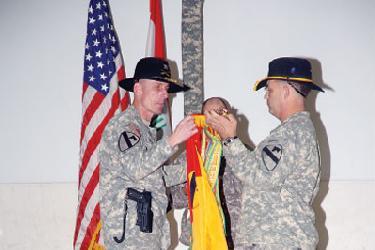 |
|---|
| 3rd ACR Transfers Authority to 3rd BCT |
|---|
| |
|---|
 On 19 January 2009, in a Transfer of Authority ceremony on Forward Operating
Base Marez, the 3rd Armored Cavalry Regiment cased its colors and handed over
the reins of Nineveh Province to the 3rd Heavy Brigade Combat Team, 1st
Cavalry Division. The 3rd Armored Cavalry Regiment has completed its 15-month
deployment and will return to Ft. Hood, while the 3rd Heavy Brigade Combat
Team, 1st Cavalry Division, also from Ft. Hood, uncased its colors for their
12-month deployment for OPERATION Iraq Freedom - VI. (Rotation 08-10).
On 19 January 2009, in a Transfer of Authority ceremony on Forward Operating
Base Marez, the 3rd Armored Cavalry Regiment cased its colors and handed over
the reins of Nineveh Province to the 3rd Heavy Brigade Combat Team, 1st
Cavalry Division. The 3rd Armored Cavalry Regiment has completed its 15-month
deployment and will return to Ft. Hood, while the 3rd Heavy Brigade Combat
Team, 1st Cavalry Division, also from Ft. Hood, uncased its colors for their
12-month deployment for OPERATION Iraq Freedom - VI. (Rotation 08-10).
 On 26 July, three joint security stations within the city of Mosul were
transferred Sunday by the 3rd Brigade Combat Team, 1st Cavalry Division, to
the Government of Iraq in accordance with the US-Iraq Security Agreement.
However, as agreed by the governments of Iraq and the United States, the joint
security stations, Hotel, Castle and Mountain, remained open past the 30 June
deadline to house transition and advisory teams, maintain stable security and
increase the capability of Iraqi Security Forces.
On 26 July, three joint security stations within the city of Mosul were
transferred Sunday by the 3rd Brigade Combat Team, 1st Cavalry Division, to
the Government of Iraq in accordance with the US-Iraq Security Agreement.
However, as agreed by the governments of Iraq and the United States, the joint
security stations, Hotel, Castle and Mountain, remained open past the 30 June
deadline to house transition and advisory teams, maintain stable security and
increase the capability of Iraqi Security Forces.
 JSS Hotel was the first base of the day to be transferred. Officials presiding
over the ceremony included the mayor of Mosul, the 3rd Federal Police Division
commander, the Mosul Brigade commander, and US military leaders from the 3rd
Battalion, 8th Cavalry Regiment, 3rd BCT, 1st Cavalry Division. After a few
short speeches, Brooks and the Receivership Secretariat, Sameer Alhaddad,
signed papers transferring the property to the Government of Iraq.
JSS Hotel was the first base of the day to be transferred. Officials presiding
over the ceremony included the mayor of Mosul, the 3rd Federal Police Division
commander, the Mosul Brigade commander, and US military leaders from the 3rd
Battalion, 8th Cavalry Regiment, 3rd BCT, 1st Cavalry Division. After a few
short speeches, Brooks and the Receivership Secretariat, Sameer Alhaddad,
signed papers transferring the property to the Government of Iraq.
 Immediately after the transfer ceremony at JSS Hotel, the Alhaddad went to
JSS Castle, where the Gogjali District IP commander, Colonel Sheet Admeer,
and Major Scott Carpenter, operations officer for 3rd Brigade Special Troops
Battalion, awaited his arrival. JSS Castle was home to the Gogjali District
Iraqi Police Transition Team from the 351st Military Police Company, a Florida
reserve unit. The 351st MP Co. is now moving to Forward Operating Base Sykes
to focus on a new mission with the 6th Battalion, 9th Cavalry Regiment, 3rd
BCT.
Immediately after the transfer ceremony at JSS Hotel, the Alhaddad went to
JSS Castle, where the Gogjali District IP commander, Colonel Sheet Admeer,
and Major Scott Carpenter, operations officer for 3rd Brigade Special Troops
Battalion, awaited his arrival. JSS Castle was home to the Gogjali District
Iraqi Police Transition Team from the 351st Military Police Company, a Florida
reserve unit. The 351st MP Co. is now moving to Forward Operating Base Sykes
to focus on a new mission with the 6th Battalion, 9th Cavalry Regiment, 3rd
BCT.
 The final transfer involved JSS Mountain, located in the neighborhood of
Judaydat Al Mufti. Since January, Mountain has been used to conduct
operations in east Mosul that involve the Iraqi Army and 2nd Battalion, 82nd
Field Artillery Regiment, 3rd BCT. US Soldiers living at JSS Mountain finished
packing early in the morning, loading the last of Mountain’s belongings onto a
Heavy Expanded Mobility Tactical Truck.
The final transfer involved JSS Mountain, located in the neighborhood of
Judaydat Al Mufti. Since January, Mountain has been used to conduct
operations in east Mosul that involve the Iraqi Army and 2nd Battalion, 82nd
Field Artillery Regiment, 3rd BCT. US Soldiers living at JSS Mountain finished
packing early in the morning, loading the last of Mountain’s belongings onto a
Heavy Expanded Mobility Tactical Truck.
 Operation IRAQI DRAWDOWN, 2009 - 2010
Operation IRAQI DRAWDOWN, 2009 - 2010

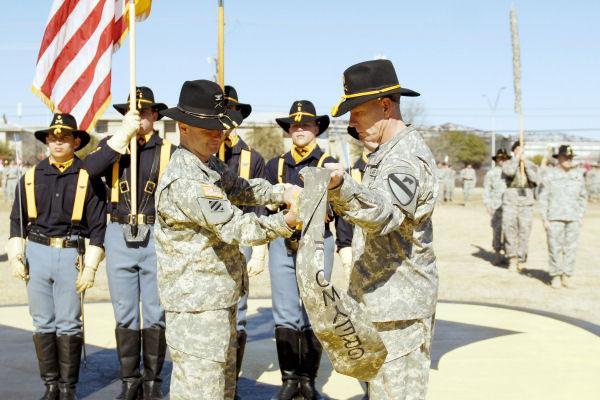 |
|---|
| Grey Wolf Troopers Case Their Colors |
|---|
| |
|---|
 On 21 January, 2011, a new mission in a new location began for the Greywolf
Troopers as the 3rd Brigade Combat Team, 1st Cavalry Division cased its unit
colors Friday on the Cooper Field. The event marked the most recent of many
milestones for the brigade.
On 21 January, 2011, a new mission in a new location began for the Greywolf
Troopers as the 3rd Brigade Combat Team, 1st Cavalry Division cased its unit
colors Friday on the Cooper Field. The event marked the most recent of many
milestones for the brigade.
 Upon casing the colors, the Greywolf troopers became members of the 3rd Advise
and Assist Brigade, Task Force Vigilant in preparation for their fourth
deployment to Iraq in the coming weeks. In addition, the brigade formally
activated three Stability Transition Teams, comprised of 45 field-grade
officers to assist with the new mission in Iraq. The three teams, each led by
a lieutenant colonel, will train, mentor and assist, as necessary, their
Iraqi counterparts.
Upon casing the colors, the Greywolf troopers became members of the 3rd Advise
and Assist Brigade, Task Force Vigilant in preparation for their fourth
deployment to Iraq in the coming weeks. In addition, the brigade formally
activated three Stability Transition Teams, comprised of 45 field-grade
officers to assist with the new mission in Iraq. The three teams, each led by
a lieutenant colonel, will train, mentor and assist, as necessary, their
Iraqi counterparts.
 Stability Transition Teams are just one of the new aspects of this deployment
for Greywolf. Although this will be the fourth deployment to Iraq for the
Brigade, the mission has changed drastically since the formal end of combat
operations in September 2010 and the transition to Operation NEW DAWN. This
time, Greywolf troopers will be assisting and advising Iraqi Security Forces
in southern Iraq. Though the mission has changed to one of support, there are
still dangers.
Stability Transition Teams are just one of the new aspects of this deployment
for Greywolf. Although this will be the fourth deployment to Iraq for the
Brigade, the mission has changed drastically since the formal end of combat
operations in September 2010 and the transition to Operation NEW DAWN. This
time, Greywolf troopers will be assisting and advising Iraqi Security Forces
in southern Iraq. Though the mission has changed to one of support, there are
still dangers.
 The troopers trained as they have for previous deployments, but with the
additional focus on cultural awareness, a nod to the improved conditions in
Iraq. Through U.S. efforts over the past seven years, conditions are now such
that Iraqi capability and capacity have finally reached a point where a
transition from military-led operations,
The troopers trained as they have for previous deployments, but with the
additional focus on cultural awareness, a nod to the improved conditions in
Iraq. Through U.S. efforts over the past seven years, conditions are now such
that Iraqi capability and capacity have finally reached a point where a
transition from military-led operations,
 Upon their arrival in Iraq, the Greywolf brigade will assume responsibility
for Iraq’s four southernmost provinces and portions of the country’s borders
with Saudi Arabia, Kuwait and Iran in partnership with two Iraqi army
divisions, a division of border enforcement, four provincial chiefs of police
and more than 50 local and regional police stations, The brigade also will be
tasked with dissolving four Provincial Reconstruction Teams and assisting with
the stand-up of a US Consulate in Basra.
Upon their arrival in Iraq, the Greywolf brigade will assume responsibility
for Iraq’s four southernmost provinces and portions of the country’s borders
with Saudi Arabia, Kuwait and Iran in partnership with two Iraqi army
divisions, a division of border enforcement, four provincial chiefs of police
and more than 50 local and regional police stations, The brigade also will be
tasked with dissolving four Provincial Reconstruction Teams and assisting with
the stand-up of a US Consulate in Basra.
 The 3rd Brigade Special Troops Battalion, the last Army unit to leave Iraq
Saturday night, had been stationed at Contingency Operating Base Adder, which
was the last base to close. After about 20 minutes, the white buses turned
onto Battalion Avenue and soldiers stared silently out the windows at the
cheering crowds - their voices muffled by the windows and the engines of the
buses.
The 3rd Brigade Special Troops Battalion, the last Army unit to leave Iraq
Saturday night, had been stationed at Contingency Operating Base Adder, which
was the last base to close. After about 20 minutes, the white buses turned
onto Battalion Avenue and soldiers stared silently out the windows at the
cheering crowds - their voices muffled by the windows and the engines of the
buses.
|
|
|---|
| 3rd Brigade At Khabari-Crossing |
|---|
|
|
|---|
 This is a video of the last convoy of heavily armored personnel carriers,
known as Mine Resistant Ambush Protected (MRAPs) vehicles, of the 3rd Advise
and Assist Brigade, 1st Cavalry Division. They had left the staging base at
Camp Adder in southern Iraq in Sunday's early hours. No formal "exit
ceremony" was given as they slipped out under cover of darkness and strict
secrecy to prevent any final attacks. The 500 soldiers didn't even tell their
Iraqi comrades on the base they were leaving.
This is a video of the last convoy of heavily armored personnel carriers,
known as Mine Resistant Ambush Protected (MRAPs) vehicles, of the 3rd Advise
and Assist Brigade, 1st Cavalry Division. They had left the staging base at
Camp Adder in southern Iraq in Sunday's early hours. No formal "exit
ceremony" was given as they slipped out under cover of darkness and strict
secrecy to prevent any final attacks. The 500 soldiers didn't even tell their
Iraqi comrades on the base they were leaving.
The film clip begins as they were preparing to leave Iraq and enter Camp
Virginia, Kuwait through the Khabari-Crossing that has been the gateway for
the passage of troops, equipment, and supplies, between Iraq and Kuwait during
Operation Iraqi Freedom as well as Operation New Dawn.
 The movement of the 3rd Brigade, as the last unit to redeploy out of Iraq,
symbolizes the closing of a mission spanning nearly a decade. This last unit
to pass through the Khabari-Crossing played an essential role in Iraq since
the start of Operation Iraqi Freedom in Iraq in 2003. The Gray Wolf Brigade
was there at the beginning of the mission and now, as Operation New Dawn ends,
they will be a part of history in the making - and, in their legacy, will see
the mission to the very end.
The movement of the 3rd Brigade, as the last unit to redeploy out of Iraq,
symbolizes the closing of a mission spanning nearly a decade. This last unit
to pass through the Khabari-Crossing played an essential role in Iraq since
the start of Operation Iraqi Freedom in Iraq in 2003. The Gray Wolf Brigade
was there at the beginning of the mission and now, as Operation New Dawn ends,
they will be a part of history in the making - and, in their legacy, will see
the mission to the very end.















 eMail Your WebSite Comments.
eMail Your WebSite Comments.


 Return to "MyOwnPages"©.
Return to "MyOwnPages"©.

Copyright © 1996, Cavalry Outpost Publications ® and
Trooper Wm. H. Boudreau, "F" Troop, 8th Cavalry Regiment (1946 - 1947). All
rights to this body of work are reserved and are not in the public domain, or
as noted in the bibliography. Reproduction, or transfer by electronic means,
of the History of the 1st Cavalry Division, the subordinate units or any
internal element, is not permitted without prior authorization. Readers are
encouraged to link to any of the pages of this Web site, provided that proper
acknowledgment attributing to the source of the data is made. The information
or content of the material contained herein is subject to change without
notice.
Revised 21 Feb '12 SpellChecked



![]()
 The Early Years, 1917 - 1942
The Early Years, 1917 - 1942




















